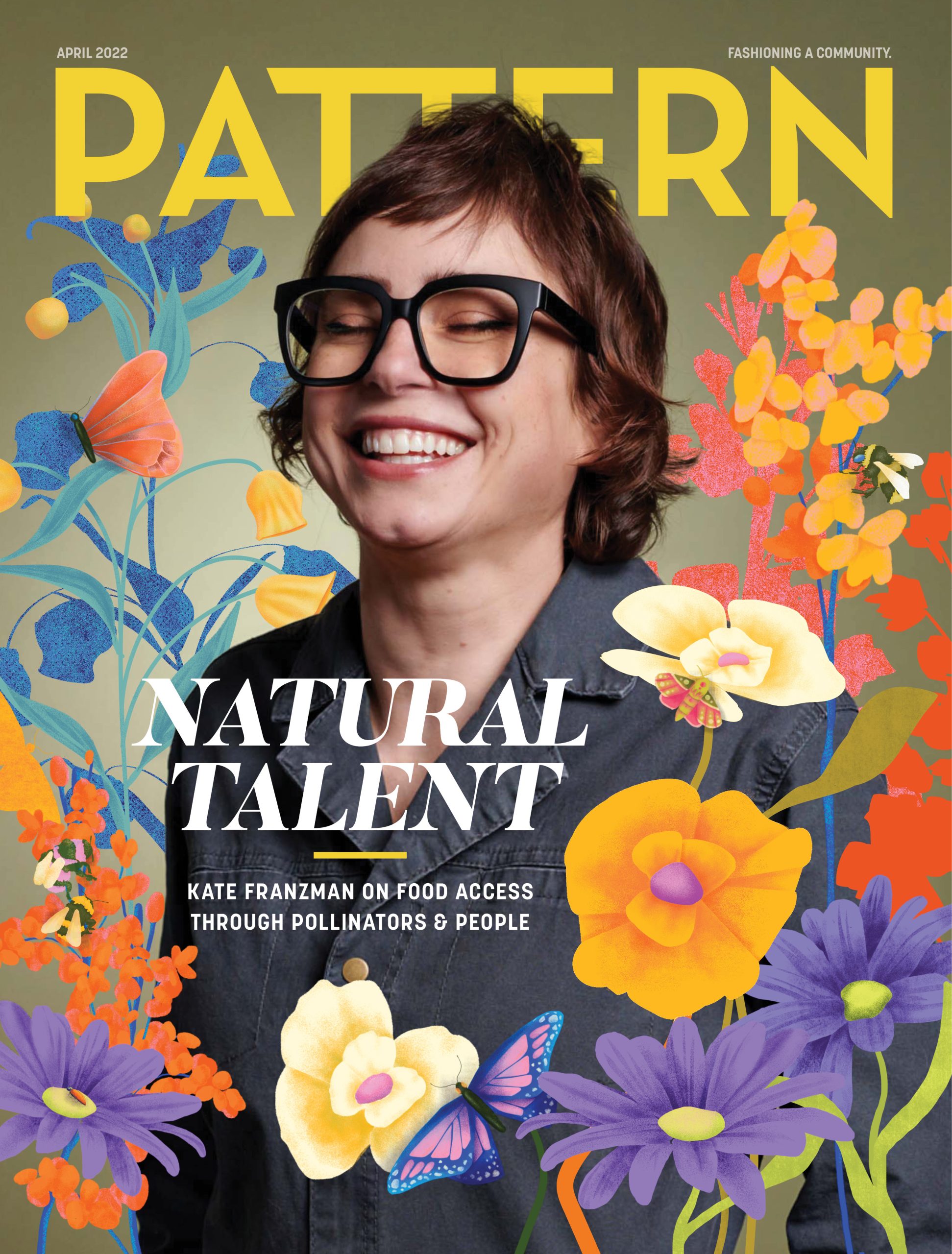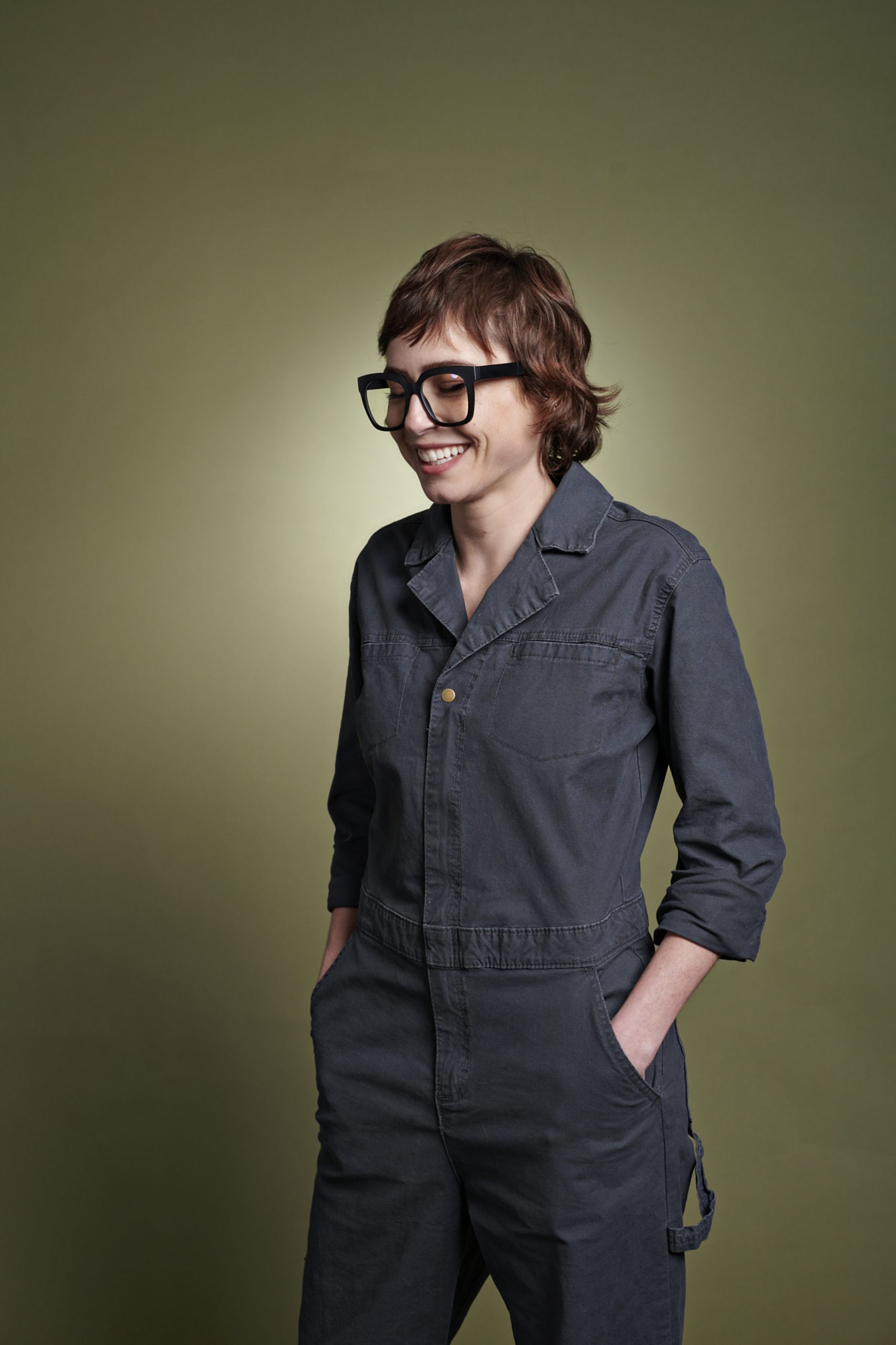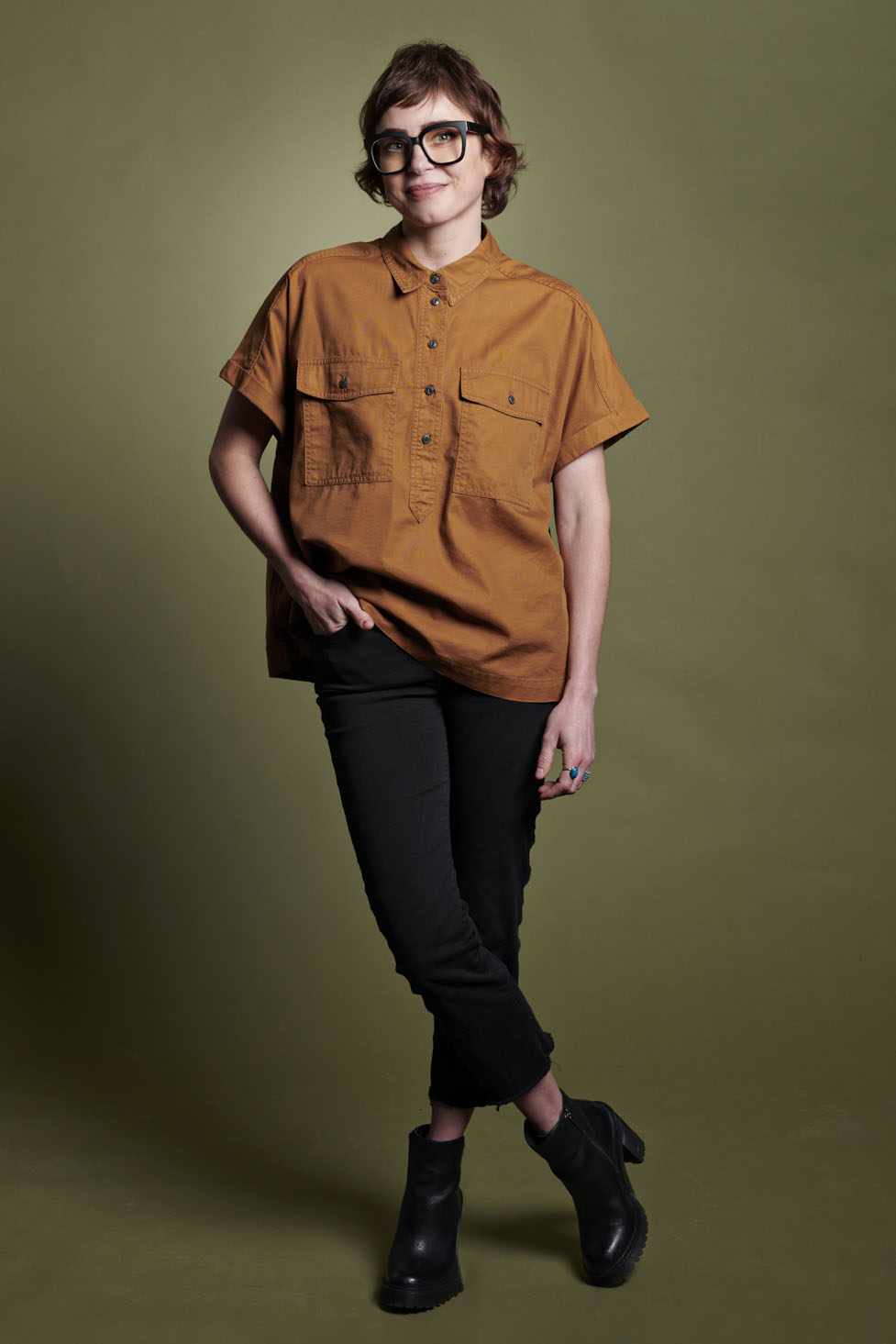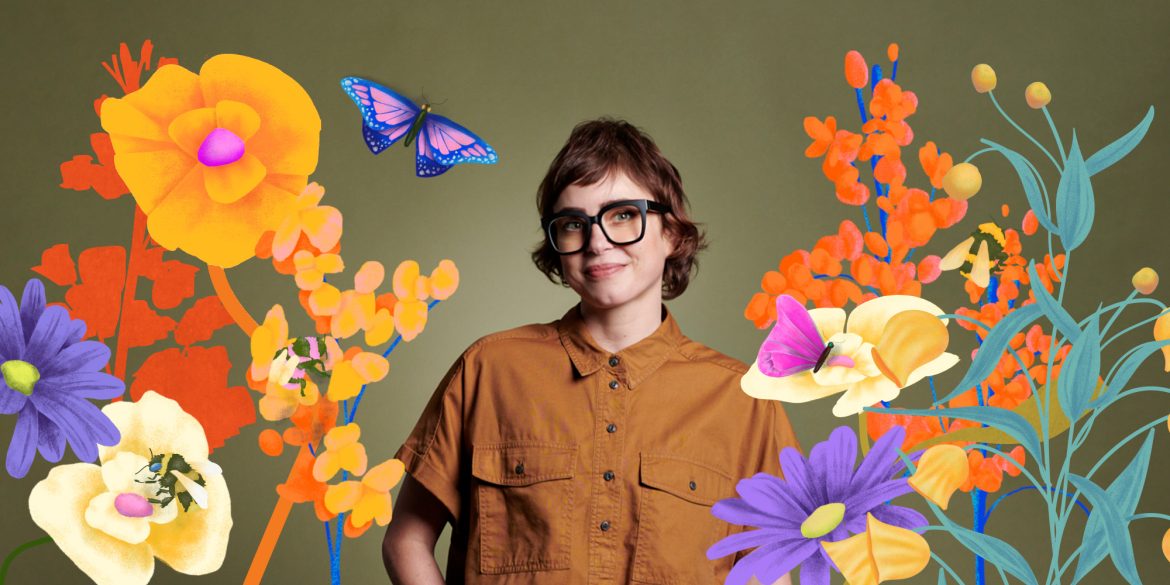At Pattern, fashioning a community is always in style. Supporting our fellow community builders and learning more about what we can do to uplift our peers are essential actions in our work. Indianapolis is lucky to have so many progressive organizations and individuals working toward a more sustainable future. This spring we decided to focus on the planet Earth; the ground on which our city was built. Who better than Kate Franzman to give us some guidance and inspiration? Franzman is an urban farmer and beekeeper who shows us agriculture is more accessible to us city-dwellers than we might think. Check out our conversation to learn more about how you can help care for pollinators and our planet. Plus, get inspired to grow your own food!
Photography by Esther Boston
Cover and header design by Carrie Kelb

Cory Cathcart: For starters, tell me about your work.
Kate Franzman: I started Bee Public in 2011or 2012. At the time I was working at an ad agency, so my background is in marketing, communications and copywriting. I left advertising to start farming and at the same time I started Bee Public. It was something I really enjoyed doing. Now I work for the Patachou Foundation, which is an anti-hunger organization in Indianapolis. My title is Director of Impact. I have two farms that I manage. I manage all of our farming operations, and the logistics and curriculum for our youth programs. And I track the success of all of our initiatives. Bee Public education and the youth education piece fits right into that. When we have field trips with elementary and middle school students, not only are they learning about pollinators, but they’re learning about soil health and how to grow food and how to cook their own food. All of these things intertwined together is the long story short.
CC: Going from advertising to farming, how did that happen? Was it hard at first?
KF: I had no experience, really, in growing my own food. Both my mother and grandmother had incredible gardens, so I was exposed to it when I was a kid. And I’ve always enjoyed being outside. I think that was the biggest impetus for me to take such a big leap into something that I had no experience in. I just kept thinking, “I’m in an office every day, all day. I just want to go outside.” I grew up in Auburn, Indiana, which is a farming community. I grew up in a house that was literally corn and soy on either side. The idea of farming to me growing up was very different than I think of it now, and I did not think it was a path that I could take. You picture a farmer and you picture an old white man. We have this idea. And honestly, because I was working in content creation, I really think I just came across somebody’s blog. They lived in New York City and they had a rooftop farm and beehive, and I thought, “Oh, now this seems more like an option for me.” I sort of secretly became obsessed with this idea. Then an opportunity came up to do an apprenticeship for a nonprofit farm called Growing Places Indy, and I interviewed. When they sent me the acceptance email, I was like, “Okay, now I have to quit my job to do this. This is a full time thing.” So that made that transition a little bit easier. I was learning how to do all the basics. Then they hired me at the end of the season to build a farm that’s at the Legacy Center on the near east side. I worked with them for about three years, and then found my way to the Patachou Foundation, and the Patachou Restaurant Group. Now we have two farms and they intertwine with our mission. I get to be outside anytime I want and they get to teach other people how to grow their own food.
CC: I know you have a lot of tips that you share about starting a garden. What do you think keeps people from growing their own food?
KF: Growing food is a science experiment that you perform every day. I think that’s the biggest thing– people are worried they’re gonna screw it up. That’s actually what you’re supposed to do when you garden. You have to learn by doing it. Because of where our farms are located, they’re very public spaces. One is along the Monon Trail and one is on 46th Street. I have the opportunity to have daily interactions with people who want to learn or want to volunteer, so they get that hands-on experience before they grow their own garden. And sometimes people stop and give me tips about what they’ve learned. The cool thing is it’s really accessible. You don’t have to have fancy equipment or a $300 compost bin. It’s nature, right? It’s something that’s been happening even before humans decided to pursue agriculture. And when we look at it as a natural process that would happen really without your help, you’re just there to kind of steward it along, I think that makes it a little bit easier for people to take up that as a hobby or even as a business.

CC: I love the idea that it would happen without us, it really does make it less scary to take on. Nature is all so connected. What does that connection mean to you and how does it affect what you do?
KF: I think that’s the biggest thing that I’ve learned and really continuously relearn is that everything is connected. It’s just a series of systems. You can’t take away one part of that and have it be successful. When you’re growing food you have to realize that pollinators, beneficial insects, and even mushrooms and all the earthworms and other decomposers that live in the soil, it’s all working together. You can’t take one of one of those pieces away. It’s been very interesting. This all happens without me, and I’m just here to witness it and observe it. A huge part of growing plants is using your observation skills. I always ask students when they come to the farm, “What do you think is the most important tool for gardening?” They say, you know, shovel or a rake or a hoe, and some of them will say your hands, and I always say, “Your hands are your second most important. The first most important thing is your eyes.” You have to constantly observe the tiny little nuances every day, and then you learn from them just like in a science experiment.
CC: What are some ways that you spread awareness of the danger of losing bees, and what are some tips that you can share?
KF: A lot of people become aware of the crisis of losing bees through honey bees. Honeybees are sort of the spokesbugs for pollinators. And truthfully, I got into beekeeping and came into it from that angle too. We think about honeybees, right? Because they make honey and they live in a certain way that humans can sort of harness and keep them like livestock. They live in a hive; they stay in one place. They come home every night to the same place. They live in this incredibly complex society, and there are all these rules and things that they do to be self-sustaining. Then they make this product that people can harvest and sell. I always make sure to tell people about other types of pollinators who are actually in more danger of disappearing than honeybees. Beekeepers can recoup any losses with honeybees because of the way that they can be managed. Native pollinators are not producing anything for us, and they don’t live the same way; many are solitary so they don’t get as much attention. When I talk about pollinators I can go on and on about honeybees, which are actually not native to the United States. They’re European honeybees. They were brought over when America was settled. They’re not invasive, but they’ve become naturalized. They were brought over not because of their honey, but because they produce wax and at the time we really needed wax for candles. They produce quite a bit of wax and it was used for candles because the alternative was using animal fat, which you can imagine burning that would be really stinky. Honey bees have always been prized for something that they make. Back to the questions of tips: planting flowers, flowers are food for bees. I was surprised to find a lot of people don’t know that honey bees make food for themselves. Their honey is their own food, and it’s for them. So the more flowers we can plant, especially native plants, we provide more food for all the pollinators. Not using anything that ends with -cide: pesticides, fungicides. Not reaching for that can of RAID when you see a carpenter bee. Learning to live with nature instead of constantly fighting it is really important. It’s really hard. We have that impulse to protect our spaces and our home. We find a lot of spiders on the farm. In the summer we have a program called the Food Fellowship for high school students. It’s a paid workforce development program that teaches kids skills in the food system. They work with me on the farm, they work in our kitchen, they work in our coffee shop; and when they’re on the farm, it takes a minute sometimes for everybody to be okay with all of the bugs… like so many bugs. When we see a spider we talk about the benefits– how spiders are great for the garden. I know a lot of people have the impulse if they see a spider in their house to kill it. We just have to fight our human impulses. I think that’s the biggest thing, is trying not to use those chemicals on every little bug that you see
CC: What are some examples of other pollinators?
KF: A pollinator is any creature that visits flowers for nectar and as a result transfers pollen from one flower to another and fertilizes that plant so that our food can grow. Hummingbirds, bats, even flies and moths, they all do this. Some are, I guess from our perspective, better at it than others. Honey bees are not the best pollinators. Mason bees are actually really good pollinators. They are not the most efficient, but they pollinate more than honey bees because they do a little belly-flop into the middle of the flower and the pollen goes everywhere. There’s some pollinators, like bumble bees and carpenter bees, that vibrate so much and they’re really loud and big; so they are more helpful to some plants than others. That’s the really cool thing; that everything is on a cycle and things start to bloom and certain pollinators rely on certain plants and vice versa. That’s why climate change is such a big deal, because it throws off that natural cycle and some things bloom too early. Everybody’s schedule is off.
CC: What is the purpose of the gardens you manage? Do they provide food for the restaurant group?
KF: Each garden has its own purpose for the produce that’s grown, but it all works together. It’s a nice ecosystem. The garden that is along the Monon Trail by the Public Greens restaurant, everything that we grow there I coordinate with the chef’s at Public Greens on what to grow, and then everything goes into that kitchen. All the proceeds from Public Greens go to the Patachou Foundation, our nonprofit. Everything that’s grown at the garden at 46th Street goes into our production kitchen and we make meals for kids; about 1500 to 2000 meals each week for kids at public schools and community centers. Creating meals from scratch and delivering them to kids around the city is one facet of what we do, and that’s been since the very beginning as a way of fighting hunger through that immediate need of food and nutrition security. The garden is also used as a classroom. We have elementary and middle school students that come on field trips. It’s used as a teaching tool, but also when you come to a garden you’re gonna have a snack. We always make that part of the trip; picking something right from the garden and either eating it immediately, or using it to make a really simple recipe and practicing knife skills, measurements, and that kind of stuff. This summer we will launch a neighborhood farm stand and sell some of the produce that we grow. That will be managed by our high school Food Fellows that are with us for the summer. Really excited about that. We’ve done a lot of work in the last year to build all these different things, and this year we finally get to use them. So it’s exciting.

CC: What can people do to help Indianapolis become a place that prioritizes home and community gardening?
KF: That’s a great question. I think everybody should have their own garden. Not just to grow their own food, but to reconnect with nature as cheesy as that sounds. I think it’s very rewarding. It doesn’t take much to grow enough to feed yourself and your family. But also, that’s not convenient for everybody and that’s fine. I think overall if Indianapolis wants to move in a new direction we’ll have to look at policies around land access for people to start their own farm, and support from the city in that kind of endeavor. There are cities like Detroit, for example, where when you go there you realize that gardening and urban farming is just incredibly entrenched in the culture. Everybody has a garden whether it’s a community garden or a backyard garden. There are urban farms everywhere.There are upwards of 1,600 community gardens and urban farms in Detroit, and Indianapolis has around 100.* That’s a big difference. There are many factors and historical context that led Detroit to have this kind of culture. I think Indianapolis would benefit from thinking about vacant land in a different way. We don’t have to put a new building there, or a new apartment building, or a condo. We could set aside some land and make it much easier for people to turn that into a space to grow food for their community. There are big systems at play.
*According to Purdue University’s Urban Agriculture page, Indianapolis has 134 urban and community gardens and around 20 urban farms. However, we could not find an exact number that is a more current statistic.

